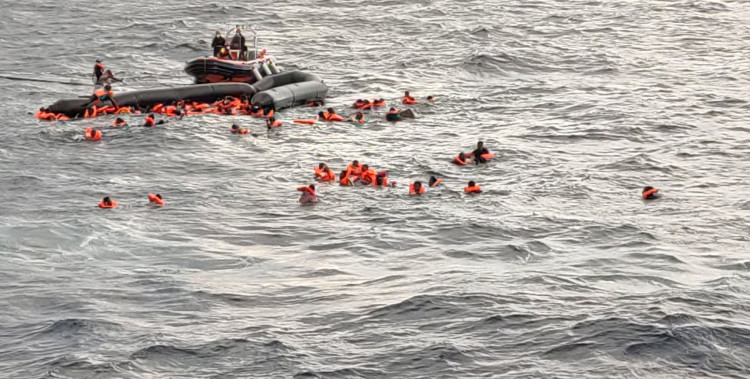While Mediterranean storm Daniel wreaked havoc in Europe last week, causing fatalities in countries like Greece and Turkey, its impact in northeastern Libya resulted in one of North Africa's deadliest floods since 1927.
On September 10, storm Daniel made landfall in northeastern Libya, triggering torrential rains. Eastern cities like Beida and Tobruk experienced flooding, but the northeastern coastal city of Derna, which had been repeatedly bombed during the Libyan civil war, was hit hardest.
After the floodwaters destroyed two long-neglected dams near Derna, they inundated the city of 100,000 residents. As of the evening of September 12, the eastern Libyan government had recovered over 1,500 bodies, with some officials estimating the death toll could surpass 5,000.
Tamer Ramadan, the International Federation of Red Cross and Red Crescent Societies' envoy to Libya, estimates that at least 10,000 people in Derna are still missing, with over 40,000 left homeless.
The deadliest flood in North Africa since 1900 occurred in 1927 in Algeria, claiming 3,000 lives. The projected death toll from this Libyan flood has already surpassed that of Algeria.
The ongoing civil war in Libya since the fall of Gaddafi and the current standoff between two governments have exacerbated the devastation of this historic flood.
Dam Collapse
A spokesperson for the eastern Libyan government stated that after two upstream dams near Derna collapsed in succession, floodwaters rushed down the riverbed towards the city, destroying three bridges and sweeping many homes into the sea.
Derna currently has no electricity, and the city is covered in mud, fallen trees, cars, and debris from collapsed buildings. Ahmed Madroud, Derna's deputy mayor, shared that at least 20% of the city has been washed away based on the information he received.
The Libyan National Meteorological Center, affiliated with the western National Unity Government, claimed that they had issued a warning 72 hours before storm Daniel made landfall, urging local governments to take preventive measures. From last Sunday to Monday, the eastern city of Beida received more than 414mm of rain.
However, since the meteorological center is aligned with the western government and Derna is controlled by the eastern government, local residents said they received no prior warning of the flood. Authorities had no evacuation plans in place, and residents only realized the impending flood when they heard the loud noise of the dam's collapse.
The east-west government rivalry has also hindered rescue efforts in Derna. The Central Bank of Libya, responsible for providing relief funds to affected areas, only recognizes the western National Unity Government. Deputy Mayor Madroud said they are waiting for aerial relief supplies from neighboring Algeria and called on the international community for assistance.
Currently, Turkey, Italy, the UAE, and Egypt have announced the dispatch of rescue teams. Later on Tuesday, the western Libyan government pledged $400 million worth of supplies for the reconstruction of Derna and other eastern towns.
Crumbling Infrastructure
Most of Derna's modern infrastructure was built during Gaddafi's era, including one of the collapsed dams from the 1970s. Madroud revealed that the two collapsed dams hadn't been maintained since 2002, with one of them standing only 70 meters tall.
After Gaddafi's overthrow in 2011, Libya plunged into nearly a decade of civil war. Derna, at one point, became a stronghold for extremist groups and was frequently bombed by the Egyptian military. In 2019, Khalifa Haftar, who supports the eastern government, took control of Derna.
Due to mistrust of Derna's residents, Haftar did not order large-scale reconstruction of the city. Only last year did the eastern Libyan government devise a reconstruction plan for Derna, but the plan's executors were from Benghazi, where the eastern government is based, rather than local Derna residents.
The full-scale civil war in Libya continued until 2020. During the conflict, the western and eastern governments each received support from foreign powers. The UN-recognized western National Unity Government was backed by Turkey, Qatar, and Italy, while Egypt, Russia, Jordan, the UAE, and France supported Haftar.
In 2019, Haftar's forces advanced into Libya's capital, Tripoli. Turkey and Qatar increased their military support to help the western government repel Haftar's forces. After 14 months of fighting, Haftar retreated from Tripoli. Soon after, with mediation from multiple countries, the western and eastern governments agreed to a ceasefire.
After the ceasefire, Libya initially planned to hold general elections in 2021 to elect a unified government. However, the elections have yet to take place, and sporadic clashes between pro-western and pro-eastern forces continue. Just last month, clashes in Tripoli resulted in at least 45 deaths.
Hani Shennib, chairman of the U.S.-Libya Relations National Committee, believes that this flood in Libya is not just a natural disaster but primarily a man-made catastrophe, a tragic outcome of years of war and neglected infrastructure.






